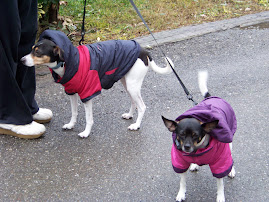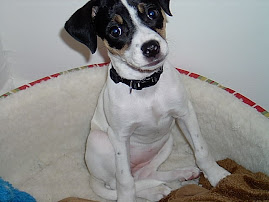
The Rat Terrier is an American dog breed with a rich and varied background as an all-around farm dog. Traditionally more of a type than a breed they share much ancestry with the tough little mixed breed dogs known as 'feists.' Several private associations have maintained Rat Terriers registries for some decades, but more recently there have been movements to obtain breed recognition by the major canine organizations.
Common throughout America on family farms in the 1920s and 30s, they are generally considered a rare breed[1]. Today's Rat Terrier is a handsome, intelligent, active little dog that is equally cherished as a farm helper and as a family pet.
The Rat Terrier ranges from about 10 to 25 pounds and stands 13 to 18 inches at the shoulder. The miniature size (13 inches and under as defined by the UKC) is becoming increasingly popular as a house pet and companion dog. A larger strain, often in excess of 25 pounds, has been developed.
These Deckers or Decker Giants were named after a breeder named Milton Decker to create a larger hunting companion and are recognized by the National Rat Terrier Association (NRTA, see Breed recognition below). The NRTA recognizes a Toy Variety weighing 10 pounds or less, and continues to classify the Teddy Roosevelt Terrier as the Type B Rat Terrier. In any event the Toy and Miniature Rat Terriers display the same hardiness, prey drive, and stamina as their standard sized counterparts.
Although often mistaken for a Jacl Russell Terrier, the Rat Terrier has a different profile and a very different temperament. Rat Terriers are finer of bone and have a more refined head. They always have a short single coat, i.e. they are never wire coated. Rat Terriers tend to be less aggressive than Jack Russells; while they have a definite terrier personality they also have an "off switch" and love lounging on the sofa in a lap as much as tearing about the yard.
Rat Terriers are normally cheerful dogs but they tend to be more sensitive and at times calmer than Jack Russells to changes in their environment, owner's moods, or to unexpected noises, people, and activities.
The "social sensitivity" of Rat Terriers makes them very trainable and easier to live with for the average pet owner but it also means that extensive socialization from an early age is critical. Proper socialization of a rat terrier puppy includes exposing the animal to a wide variety of people and places, particularly during the first 3 months of life. Like most active and intelligent breeds, Rat Terriers tend to be happier when they receive a great deal of mental stimulation and exercise.
In the 1970s, a hairless mutation appeared in a single Rat Terrier bitch, and was propagated into a strain of the Rat Terrier. After a period of development by crossing to coated dogs, the United Kennel Club (UKC) recognized the American Hairless Terrier as a separate breed in 2004.
Source of Information:
http://en.wikipedia.org/wiki/Rat_Terrier









